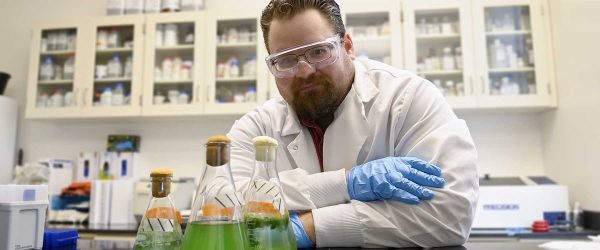Diving deep for clues that lead to the origins of life on Earth — and possible solutions to climate change

Above the still crystal-clear blue waters of Mexico’s Lake Bacalar lies one of the world’s largest formations of modern microbialites. Cenote Azul was discovered recently by a team of international researchers that includes UNC Charlotte’s Richard Allen White III, a computational and molecular virologist and assistant professor of bioinformatics and genomics in the College of Computing and Informatics.
Within this complex ecosystem is a collection of modern microbialites — a kind of “living rock” — that hold the key to unlocking clues to persistent unknowns about how life on Earth began and evolved, and contains the properties to conceivably mitigate the effects of climate change.
Divers from the organization CINDAQ, whom facilitate research, promote education and support the conservation of the natural and cultural resources associated with the cenotes and underground rivers of Quintana Roo, Mexico, located several hectares of microbialite communities in cenotes on a hilltop two miles above Lake Bacalar. White, Eduard Reinhardt and Greg Slater, from MacMaster University in Canada, are working with Luisa I Falcon, a professor at the Bacterial Ecology Lab at National Autonomous University of Mexico, who has been studying the lake’s bacterial diversity.
A cenote, or sinkhole, is a term originating on the Yucatan Peninsula; they often are used as sources of freshwater.
“Concreted within the walls of these cenotes were pieces of pottery dating to the Mayan period,” said White. “Cyanobacteria (formally blue-green algae) as microbial mats (a layered sheet of microorganisms) traps sunlight and carbon dioxide then releases breathable oxygen via photosynthesis. The cenote is full of limestone, which dissolves fresh calcium, followed by dark carbon capture of carbon dioxide from cyanobacteria transforms greenhouse gasses into stone, basically biological concrete.”
Because mining and manufacturing methods utilized in concrete production result in high levels of environmental pollution, unlocking the chemical and biological processes used by cyanobacteria to produce concrete would prove revolutionary.
“Think about the implications,” noted White. “Discovering how these collections of microbes utilize sunlight to eliminate the excess carbon dioxide in the atmosphere could lead to producing stronger materials for constructing buildings and mitigating related environmental risks.”
Researching the origins of life
As a doctoral candidate at the University of British Columbia, White began studying modern microbialites created by microbes into a diversity of structures including stromatolites, a type of layered carbonate structure, and thrombolites, characterized by irregular-shaped, clot-like carbonate structures.
White was fascinated by these organisms and the secrets they could contain relative to the very formation of the Earth.
“Microbialites are the oldest known enduring ecosystems and may be the first evidence of life on this planet,” said White. “Researchers have dated their existence to 3.7 billion years ago, and we know they played a role in some of Earth’s earliest biogeochemical processes.”
The oldest fossilized microbialites do not have active microbes, but every year, new microbialites are discovered in aquatic and terrestrial environments.
Earlier this year, White received an ultra-competitive NASA Exobiology grant to further investigate microbialites.
“NASA’s interest in microbialites relates to their role as ‘signposts’ for life on Earth. If we eventually go to a place like Mars, Europa or Enceladus, moons that orbit Jupiter and Saturn, respectively, and were to find these structures, we could say in high likelihood life had existed there. If we found them active, we could say life in some form is still going on.”
Viruses and microbial communities
Within his Charlotte lab, White and his research team study viruses — those within the guts of mammals, in soil rhizosphere (i.e., the plant gut) — and those within microbialites.
With estimates of 1031, viruses are the most numerous biological entities on Earth. To put this number in perspective, viruses on this planet outnumber the visible stars in the night sky by 10:1.
In a post-COVID world, the study of viruses is undergoing a renaissance. While certain viruses have the potential to be detrimental to life, 99% cause no harm. They are among the collection of all microbes, such as bacteria and fungi, that live naturally in and on humans.
However, viruses have the ability to alter the metabolism of their hosts, and in the case of cyanobacteria, they potentially impact the transition from microbial mat to hard carbonate rock as a microbialite, such as those discovered in Cenote Azul.
“Active (non-fossilized) cyanobacterial microbial mats produce a wide range of metabolites, including sugars, amino acids and lipids that feed a diversified microbial population within the microbialites,” said White. “Viruses likely play a direct or indirect role in the formation of carbonates. Viral lysis, a mortality factor for bacteria, also may contribute to microbialite production.”